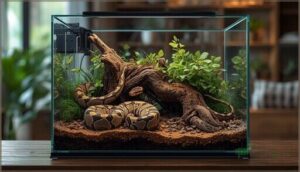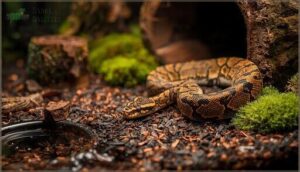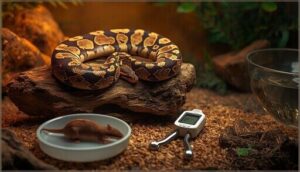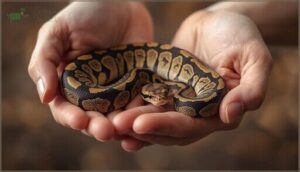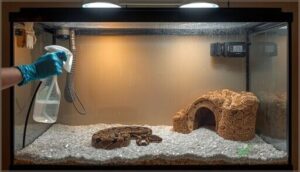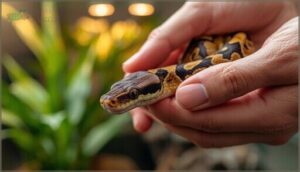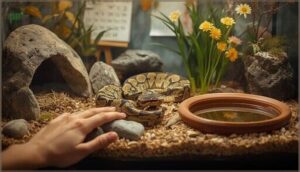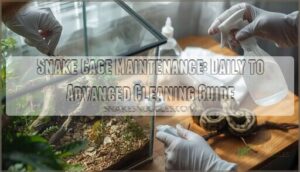This site is supported by our readers. We may earn a commission, at no cost to you, if you purchase through links.
Your new ball python coils around your hand for the first time, and you realize this gentle creature is now your responsibility for the next two or three decades. Unlike dogs or cats, these snakes won’t signal their needs with obvious cues, and they won’t forgive basic mistakes in temperature, humidity, or housing.
Many first-time owners underestimate what caring for a ball python actually demands—not just at setup, but week after week, year after year. The good news? Once you understand their specific requirements, these docile reptiles thrive in captivity with relatively straightforward care.
Getting the fundamentals right from day one prevents most health issues and creates a stress-free environment where your snake can flourish throughout its impressive lifespan.
Table Of Contents
- Key Takeaways
- Essential Ball Python Characteristics
- Choosing The Right Enclosure
- Setting Up The Ideal Habitat
- Feeding Your Ball Python Safely
- Proper Handling Techniques
- Cleaning and Daily Maintenance
- Monitoring Ball Python Health
- Responsible Ball Python Ownership
- Frequently Asked Questions (FAQs)
- Can ball pythons live together in one tank?
- How often do ball pythons need veterinary checkups?
- What lighting schedule works best for ball pythons?
- How do you introduce new decorations safely?
- Can you use live plants in ball python habitats?
- Can ball pythons live together in one enclosure?
- Do ball pythons need UVB lighting?
- How do I tell my pythons gender?
- What are signs of stress in ball pythons?
- Can ball pythons recognize their owners?
- Conclusion
Key Takeaways
- Ball pythons require a long-term commitment of 20-30 years with precise environmental control, including temperature gradients (88-92°F warm side, 78°F cool side) and 60-80% humidity levels that must be maintained consistently throughout their entire lifespan.
- Proper enclosure setup demands specific sizing based on life stage—from 10-gallon tanks for hatchlings to 55-75 gallon enclosures for adults—along with at least three hiding spots and appropriate substrate that retains moisture without causing health issues.
- Feeding schedules shift dramatically as pythons mature, with hatchlings eating every 4-7 days and adults requiring meals only every 2-6 weeks, while prey size should always match 10-15% of the snake’s body weight to prevent nutritional problems.
- Most health complications stem from husbandry mistakes rather than inherent illness, making daily monitoring of temperature, humidity, waste removal, and behavioral patterns essential for preventing respiratory infections, parasites, and shedding difficulties before they escalate.
Essential Ball Python Characteristics
Before you bring a ball python home, you’ll want to understand what makes these snakes unique. Knowing their natural tendencies, physical traits, and genetic variety helps you create the right environment and care routine.
Let’s look at the key characteristics that define ball pythons as pets.
Natural Habitat and Behavior
Ball pythons come from the warm grasslands and open forests of West and Central Africa, where they’ve mastered life in wild terrains. Understanding their natural behavior helps you create a proper ball python habitat at home.
- Nocturnal patterns: They’re most active at dawn and dusk, spending daylight hours hidden in burrows or termite mounds for thermal regulation and predator avoidance
- Burrowing behavior: These snakes rely on underground shelters rather than climbing, staying close to ground level in their reptile habitat and environment
- Defense strategy: When threatened, they curl into their signature ball rather than biting—a gentle reminder of their peaceful nature
To ensure a healthy environment, it’s vital to research ball python care for your pet.
Size, Lifespan, and Growth
Your snake will grow from a pencil-thin hatchling to a surprisingly hefty adult. Hatchlings measure 10-18 inches and weigh 30-100 grams initially. Growth patterns show juveniles reaching 24 inches by one year, with males maturing around 3-3.5 feet while females stretch to 4-5 feet. With proper ball python care and maintenance addressing lifespan factors, you’re looking at 20-30 years together—some even reach 47 years. Understanding the factors that affect ball python size, including growth rate issues, is vital for providing superior care.
| Age | Typical Size | Weight Range | Growth Stage |
|---|---|---|---|
| Hatchling | 10-18 inches | 30-100 grams | Rapid growth begins |
| 1 Year | 16-24 inches | 475-1100 grams | Juvenile development |
| 3-4 Years | 2.5-5 feet | 1200+ grams | Sexual maturity |
| Adult | 3-5 feet | Up to 7 lbs | Full size achieved |
Color Morphs and Genetics
Beyond size differences, you’ll find an astonishing genetic diversity in ball pythons. Over 7,600 documented morphs result from selective breeding strategies targeting color patterns and genetic traits.
Understanding morph inheritance—dominant, co-dominant, and recessive—helps you appreciate allele combinations like the Blue Eye Leucistic or albino variants.
Whether you’re interested in snake breeding or simply admiring these stunning color morphs, recognizing genetic diversity enriches your ball python experience.
Choosing The Right Enclosure
Your ball python’s enclosure is more than just a container—it’s their entire world. Getting the size and setup right from the start will keep your snake healthy, secure, and stress-free.
Your ball python’s enclosure isn’t just a container—it’s their entire world, and getting the size and setup right from the start keeps them healthy, secure, and stress-free
Here’s what you need to know about selecting the best home for your pet.
Recommended Enclosure Sizes
Your ball python’s enclosure dimensions directly impact its health and comfort. As your snake grows, you’ll need to upgrade space requirements to match its changing needs. Here’s what works best at each life stage:
- Hatchlings (10-17 inches): A 10-gallon tank provides security without overwhelming them.
- Juveniles (20-25 inches): Move up to a 20-gallon setup for proper temperature gradients.
- Sub-adults (1.5-3 feet): Shift to 40 gallons for better habitat maintenance.
- Adults (3-6 feet): Provide at least 55-75 gallons with 36″ × 18″ floor space.
Proper terrarium setup ensures your snake can stretch fully, thermoregulate effectively, and thrive through quality reptile husbandry with adequate ventilation and humidity control.
Best Enclosure Types
You’ll find five solid choices for your snake habitat: PVC enclosures retain humidity beautifully and insulate efficiently, glass terrariums create temperature gradients easily with overhead heating, wooden boxes offer customization when properly sealed, rack systems optimize space for multiple snakes, and plastic bins work wonderfully for nervous feeders.
Each assists proper terrarium setup and habitat maintenance—your choice depends on your specific reptile habitat and diet management needs.
Security and Escape Prevention
Without proper lid security, your ball python will vanish through openings as small as 2 inches. Ball pythons lift loose lids with surprising strength, compromising both snake health and habitat integrity.
Install lid clips rated for reptile care on screen tops, use keyed locks on front-opening enclosures, and secure plastic tubs with binder clips along the sides. These locking mechanisms are essential for enclosure safety.
Setting Up The Ideal Habitat
Once you’ve chosen the right enclosure, you’ll need to create an environment that mimics your ball python’s natural conditions. This means setting up proper heating and lighting, selecting the right substrate, and adding essential elements like hiding spots.
Let’s walk through each component to guarantee your snake feels secure and stays healthy.
Heating, Lighting, and Temperature Gradient
Your ball python needs a precise Temperature Control system to thrive. Install Heat Sources that create Thermal Gradients from 88–92°F on the warm side down to 78°F on the cool side—this range promotes proper Thermoregulation and Snake Health.
Always use a thermostat with your heating equipment to prevent dangerous overheating in the Habitat, and monitor both ends with digital thermometers for reliable Temperature accuracy.
Substrate Options and Humidity Control
Your substrate choice directly shapes humidity levels in your ball python’s enclosure. Coconut fiber, cypress mulch, and sphagnum moss retain moisture effectively—maintaining 60–80% humidity that aids healthy shedding and respiration.
Mix water into deep substrate layers rather than only misting surfaces for stable moisture control. Add a humid hide box filled with damp moss to create a localized high-humidity retreat your snake can access anytime.
Hides, Decor, and Enrichment
Your ball python thrives when its enclosure mirrors the complexity of grassland burrows. Place at least three hides—warm, cool, and humid—to support natural thermoregulation and reduce stress in 80% of cases.
Add climbing structures like angled branches and visual barriers using cork bark or live plants. These enrichment activities trigger exploration behaviors, with furnished habitats showing 20–30% more movement than minimal setups in your pet snake care routine.
Feeding Your Ball Python Safely
Feeding your ball python the right way is one of the most important parts of keeping it healthy and thriving. Getting the diet, schedule, and preparation methods right doesn’t have to be complicated, but there are some key things you need to know.
Let’s walk through what to feed, how to handle frozen rodents safely, and what to do if your snake turns picky.
Recommended Diet and Feeding Schedule
Your ball python’s feeding schedule shifts dramatically as it grows, making it essential to adjust portions and timing for ideal snake health and wellness. Understanding these stages helps you avoid overfeeding or underfeeding your companion.
- Hatchling diets: Feed every 4-7 days with prey matching 10% of body weight
- Juvenile meals: Offer food every 7-14 days as snakes reach 200-750g
- Adult frequency: Reduce to every 2-6 weeks once they exceed 500g
- Prey size: Keep portions at 10-15% body weight
- Fasting norms: Expect occasional refusals—wild adults eat under 12 times yearly
Selecting and Thawing Frozen Rodents
Once you’ve mapped out your feeding schedule, choosing quality frozen rodents becomes your next priority. You’ll want prey that’s appropriately sized—10-15% of your snake’s body weight—and properly stored to prevent freezer burn or bacterial growth.
| Prey Type | Weight Range | Best For |
|---|---|---|
| Small Rats | 45-84g | Juveniles (500-800g) |
| Medium Rats | 85-174g | Adults (up to 1500g) |
| Large Rats | 175-250g | Heavy Adults (1500g+) |
| Jumbo Rats | 250g+ | Largest Adults (2000g+) |
Thaw rodents overnight in your refrigerator at 40°F, then warm them in sealed bags submerged in water for 10-20 minutes until they reach 100-110°F internally. Never microwave prey—it causes dangerous hot spots that can harm your python’s digestive system.
Water Requirements and Bowl Maintenance
Your ball python needs fresh water daily to stay hydrated and maintain proper humidity control. Choose a sturdy bowl large enough for your pet snake to soak—about 16 oz for adults—but not so deep that juveniles risk drowning.
Clean the bowl weekly with reptile-safe disinfectant, and immediately remove any contamination. This simple routine promotes animal care and welfare while preventing scale rot.
Tips for Picky Eaters
If your ball python refuses meals, don’t panic—most feeding issues stem from husbandry problems. Try these proven strategies:
- Adjust temperatures to proper gradient levels
- Switch to smaller prey (fixes 90% of cases)
- Scent prey with rodent urine for appetite stimulation
- Wiggle frozen rodents with tongs to trigger hunting instincts
- Feed in the enclosure instead of relocating your snake
Healthy adults can safely fast seven months without concern.
Proper Handling Techniques
Handling your ball python properly helps build trust and keeps both of you safe during interactions. The key is learning when and how to pick up your snake without causing stress or triggering a defensive response.
Let’s cover the essential techniques that’ll make handling sessions comfortable and rewarding for everyone involved.
Building Trust and Reducing Stress
Trust building starts before you even touch your python. Give your new snake 1-2 weeks to settle in—don’t handle until you’ve seen two successful feedings. This acclimation period reduces relocation stress and sets the foundation for positive interactions.
During these early days, approach the enclosure slowly and avoid sudden movements. Your python’s reading your behavior, learning whether you’re a threat or a safe presence in their world.
Safe Handling Methods
Support at least 75% of your ball python’s body with both hands during handling—this prevents musculoskeletal strain and keeps your pet snake calm. Apply just enough pressure to prevent escape without restricting breathing.
Use snake hooks to guide nervous individuals from their enclosure, then cradle gently along the body. These gentle restraint techniques and handling tools form essential safety protocols for responsible constrictor care.
When to Avoid Handling
Always skip handling during a few critical times to protect your ball python’s health and prevent defensive strikes. Post-feeding care and shedding cycle management require special attention.
- Wait 24 to 48 hours after feeding to prevent regurgitation and digestive stress
- Avoid handling during blue eyes when vision is impaired and defensiveness peaks
- Skip handling during illness to support recovery and minimize stress
- Allow 7 to 14 days for new snake acclimation before first handling sessions
- Practice biosecurity measures by washing hands before and after to reduce Salmonella risk
Cleaning and Daily Maintenance
A clean enclosure isn’t just about appearance—it’s the foundation of your ball python’s health and comfort. Daily tasks keep harmful bacteria at bay, while deeper monthly cleaning ensures a safe environment for years to come. Let’s break down the specific steps that will keep your snake thriving.
Spot Cleaning and Waste Removal
Your daily routine should include a quick scan of the enclosure—think of it as a wellness check rolled into hygiene. Remove feces, urates, and soiled substrate within 24 hours to keep bacteria at bay and protect both your python’s health and your own from pathogens like Salmonella. Use dedicated tongs or scoops, then wash your hands for at least 20 seconds. Prompt waste removal also controls odor and lets you spot health changes early, like unusual stool consistency or discolored urates.
| Task | Frequency |
|---|---|
| Remove feces and urates | Within 24 hours |
| Replace soiled substrate around waste | As needed (5–10 cm radius) |
| Inspect for shed skin or uneaten prey | Daily (1–3 minutes) |
Monthly Deep Cleaning Steps
Every one to three months, you’ll disassemble the enclosure completely for deep cleaning—like resetting your python’s entire world. Move your snake to a secure holding container, then follow these steps:
- Remove and dispose of all substrate; never reuse it.
- Scrub hides, branches, and decor with a reptile-safe disinfectant like diluted chlorhexidine (contact time: five minutes).
- Rinse everything thoroughly and let it air-dry completely before reassembly checks of temperature and humidity gradients.
After deep cleaning, watch for stress-related health issues or feeding changes.
Monitoring Temperature and Humidity
You’ll rely on accurate readings from your thermometer placement—position digital probes at both warm and cool ends—to catch problems before they affect health outcomes.
Check your ball python’s temperature and humidity daily using reliable instruments, not cheap dials. If readings drift, adjust your heat source or misting routine immediately.
Consistent enclosure monitoring prevents respiratory infections and shedding complications that stem from environmental instability.
Monitoring Ball Python Health
Keeping your ball python healthy means knowing what to look for during regular checks. A healthy snake has clear eyes, smooth scales, and consistent behavior patterns you’ll recognize over time.
Let’s walk through the key health indicators and warning signs every ball python owner should understand.
Signs of Good Health
A healthy ball python moves confidently through its enclosure at night, showing responsive behavior to its surroundings. You’ll notice three key signs of good reptile health:
- Active behavior during evening hours with regular tongue-flicking
- Stable weight without unexplained loss beyond 10% during fasting
- Clear eyes and quiet breathing with no nasal discharge
Monitor these indicators between feedings for early detection of concerns requiring veterinary care.
Shedding and Grooming Needs
Your ball python will shed every 4-8 weeks, with younger snakes shedding more frequently. Watch for cloudy blue eyes signaling the shedding process—this clears 2-3 days before the skin peels off in one piece.
Maintain humidity levels at 60-75% during this time to prevent retained eyecaps. If stuck shed occurs, try a warm water soak or damp pillowcase assistance methods.
Identifying Common Illnesses
Beyond shedding problems, watch for these red flags in your ball python’s animal health:
- Respiratory infections – wheezing, mucus around the mouth, or open-mouth breathing
- Stomatitis signs – swollen gums, oral discharge, or reluctance to eat
- Parasitic mites – tiny dark specks on your snake or excessive soaking behavior
- Systemic indicators – lethargy, regurgitation, or abnormal posture
Viral conditions like inclusion body disease can also affect pythons, though they’re less common.
When to Contact a Veterinarian
When you spot breathing difficulties like wheezing or persistent open-mouth breathing, don’t wait—get veterinary medicine support within 24 hours. Weight fluctuations exceeding 10% monthly, skin problems lasting beyond two weeks, or systemic signs like convulsions demand immediate attention. Your ball python’s health issues won’t resolve alone.
Preventative care through annual exams catches problems early, and understanding snake behavior and health helps you recognize when professional animal health expertise becomes necessary.
Responsible Ball Python Ownership
Owning a ball python isn’t just about setting up a terrarium and feeding on schedule—it’s a decades-long responsibility that requires thoughtful planning and ethical choices. Before you bring one home, you need to understand the financial realities, how to keep interactions safe for everyone in your household, and where your snake should come from.
Let’s walk through what responsible ownership really looks like.
Long-Term Commitment and Costs
You’re signing up for a decades-long journey when you bring home a ball python. Lifespan expectancy often reaches 20–30 years, meaning responsible pet ownership requires careful planning around exotic pet ownership demands.
Consider these key financial realities:
- Initial expenses for setup and the snake usually range from $275 to $850
- Ongoing costs average $120 to $600 annually for feeders and supplies
- Veterinary expenses can add hundreds over time for wellness checks and health issues
- Rehoming options exist if circumstances change, often with discounted shipping
Safe Interaction for All Ages
When your household includes children, you need strict handling protocols and consistent educational practices. Child supervision isn’t optional—the CDC recommends avoiding reptile contact for kids under five because zoonotic diseases like Salmonella spread easily through indirect contact with surfaces.
| Age Group | Interaction Guidelines |
|---|---|
| Under 1 year | No reptiles in household recommended |
| 1–5 years | Avoid direct contact; supervise environment |
| 5–12 years | Handle only when seated; adult present always |
| 12+ years | Independent handling with training and household controls |
| All ages | Wash hands immediately after any snake handling or habitat contact |
Ball python behavior remains predictable when you follow safe snake handling and safety practices. Keep enclosures away from kitchens and food prep areas, secure lids prevent escapes, and teach children “touch, then wash” rules. These handling techniques protect both your family and your python’s well-being.
Ethical Sourcing and Conservation
Your choice carries weight—between 1978 and 2017, Togo alone exported up to 1.6 million ball pythons, mostly wild-caught or ranched from Western and Central Africa.
Before you buy, ask for CITES documentation and verify captive breeding claims. Avoid morphs linked to genetic disorders like wobble syndrome.
Responsible acquisition protects wild population health and aids wildlife conservation while ensuring ethical, responsible pet care for your snake.
Frequently Asked Questions (FAQs)
Can ball pythons live together in one tank?
No, ball pythons shouldn’t live together. Their solitary nature means cohabitation stress leads to resource competition, injury risks, disease spread, and breeding complications. Keep one snake per enclosure for their health and safety.
How often do ball pythons need veterinary checkups?
Most healthy adult ball pythons should visit a veterinarian trained in reptile pet care at least once yearly for preventive checkups.
Juveniles and snakes with health issues often need exams every six months.
What lighting schedule works best for ball pythons?
Set lights for 12 hours on, 12 off using a timer—this photoperiod consistency promotes nocturnal behavior in Python regius. Low UVB or bright white during daytime works well; nighttime darkness without colored bulbs maintains proper snake husbandry and temperature cycles.
How do you introduce new decorations safely?
Ironically, the safest new addition can become a hazard if rushed. You should disinfect decor first, air painted items for two weeks, quarantine decor from other pets, watch your snake’s stress response, and secure heavy pieces firmly.
Can you use live plants in ball python habitats?
Yes, you can use live plants in your ball python habitat. A bioactive setup with appropriate species selection—like pothos or snake plants—enhances humidity benefits while requiring root protection and careful attention to plant toxicity in the enclosure.
Can ball pythons live together in one enclosure?
Most keepers assume ball pythons need company, but veterinary guidelines universally recommend solitary housing.
Cohabitation stress triggers anorexia, cannibalism risks escalate during disputes, and disease transmission complicates pet snake enclosure management—even when juvenile aggregation seems peaceful.
Do ball pythons need UVB lighting?
Ball pythons don’t require UVB lighting for survival, but low-intensity exposure can benefit vitamin D3 synthesis and support natural basking behavior.
Proper lighting options improve your pet snake’s habitat while avoiding potential risks from improper setup.
How do I tell my pythons gender?
You can determine your Python regius’s gender through three main methods: cloacal popping for juveniles, probing depth assessment for adults, or genetic testing using shed skin.
Always prioritize welfare considerations by seeking professional help.
What are signs of stress in ball pythons?
Stressed snakes exhibit increased hissing frequency, defensive behaviors like balling tightly, and feeding refusal lasting weeks. These signs indicate prolonged distress in reptiles.
Activity changes include constant pacing or hiding, while corticosterone levels and breathing patterns shift during prolonged behavior disturbances.
Can ball pythons recognize their owners?
While ball pythons don’t recognize faces or voices, they do learn scent recognition and vibration sensitivity through handling habituation.
Royal pythons tolerate familiar handlers more than strangers, showing basic cognitive abilities despite limited species comparison evidence.
Conclusion
Before telegrams delivered urgent news, people trusted consistency—the same rhythm your ball python depends on now.
Caring for a ball python isn’t complicated once you’ve mastered the essentials: stable temperatures, proper humidity, consistent feeding, and routine observation. These reptiles won’t demand your attention, but they’ll silently rely on your dedication every single day.
Get the basics right, stay vigilant about their health, and you’ll watch your snake thrive for decades under your care.
- https://pmc.ncbi.nlm.nih.gov/articles/PMC8158952/
- https://www.wilbanksreptiles.com/blogs/ideal-tank-size-for-healthy-ball-pythons/what-is-the-recommended-tank-size-for-a-ball-python
- https://en.wikipedia.org/wiki/Ball_python
- https://www.jabberwockreptiles.com/news/ball-python-temperature/
- https://www.hvreptilerescue.org/resources/care-guides/ball-python-care-guide


